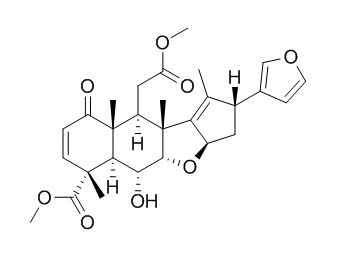Deacetylnimbin shows significant insecticidal activity to Plutella xylostlla L.and Piers rapae L.
Providing storage is as stated on the product vial and the vial is kept tightly sealed, the product can be stored for up to
24 months(2-8C).
Wherever possible, you should prepare and use solutions on the same day. However, if you need to make up stock solutions in advance, we recommend that you store the solution as aliquots in tightly sealed vials at -20C. Generally, these will be useable for up to two weeks. Before use, and prior to opening the vial we recommend that you allow your product to equilibrate to room temperature for at least 1 hour.
Need more advice on solubility, usage and handling? Please email to: service@chemfaces.com
The packaging of the product may have turned upside down during transportation, resulting in the natural compounds adhering to the neck or cap of the vial. take the vial out of its packaging and gently shake to let the compounds fall to the bottom of the vial. for liquid products, centrifuge at 200-500 RPM to gather the liquid at the bottom of the vial. try to avoid loss or contamination during handling.
Asian Pac J Trop Biomed. 2013 Oct;3(10):834-40.
Review on pharmacological and toxicologyical effects of oleum azadirachti oil.[Pubmed:
24075352]
Oleum azadirachti consists of the oil obtained from dried seeds of Azadirachta indica A. Juss. (family: Meliaceae). Local names of Azadirachta indica A. Juss. are Abodua, aforo-oyinbo, anwe egyane, arista, azad dirakht, azadarakht, azedarach and bead tree. Indigenous to India, and widely distributed in South and South-East Asia and cultivated in Africa, the South Pacific Islands, South and Central America and Australia, and in southern Florida and California, United States of America, it is a straight-boled deciduous tree, which is 6-25 m high. Bark is dark-brown, externally fissured with a buff inner surface and fibrous fracture.
Leaves alternately arranged, pinnately compound and up to 40 cm long, and composed of 8-18 short-petiolate narrow-ovate, pointed and curved toothed leaflets, 3-10 cm long and 1-4 cm wide arranged in alternate pairs. The major constituents are oxidized tetranortriterpenes including azadirachtin (azadirachtin A), azadiriadione, epoxyazadiradione, azadirone, nimbidin, nimbin, Deacetylnimbin, salannin, gedunin, mahmoodin, 17-hydroxydiradione and related derivatives.
CONCLUSIONS:
It is of various medicinal uses, such as a contraceptive for intravaginal use, a mosquito repellent, and treatment of vaginal infections, treatment of gastric ulcers, cardiovascular disease, malaria, rheumatism and skin disorders, external applications for treatment of septic wounds, ulcers and boils, treatment of allergic skin reactions, asthma, bruises, colic, conjunctivitis, dysmenorrhoea, fever, gout, headache, itching due to varicella, kidney stones, leukorrhoea, psoriasis, scabies, sprains and muscular pain, and wounds. It is also used as an emmenagogue, tonic, stomatic and vermicide.
CONCLUSIONS:
In conclusion, the plant oil had antifertility, antihyperglycaemic, anti-inflammatory, antimicrobial, antiviral, antiulcer, estrogenic, immune, contraceptive, antibacterial, insect repellent, and skin treatment effects.
Natural Product Research & Development, 2001, 13(1):9-13.
Tetranortriterpenoids from insecticidal fraction of Azadirachta indica[Reference:
WebLink]
METHODS AND RESULTS:
Ten known tetranortriterpenoids,nimbin(1),Deacetylnimbin(2),salannolide(3),azadirachtin(4),vepaol(5),isovepaol(6),3 tigloyl azadirachtol(7),1 tigloyl 3 acetyl azadirachtinin(8),3 tigloyl azadirachtinin(9),1 tigloyl 3 acetyl 11 hydroxymeliacarpinin(10),were isolated from the seed kernels of Azadirachta indica .Their structures were identified on the basis of spectral methods.
CONCLUSIONS:
The extracts containing 0.5% azadirachtin and above ten tetranortiterpenoids show significant insecticidal activity to Plutella xylostlla L.and Piers rapae L.



